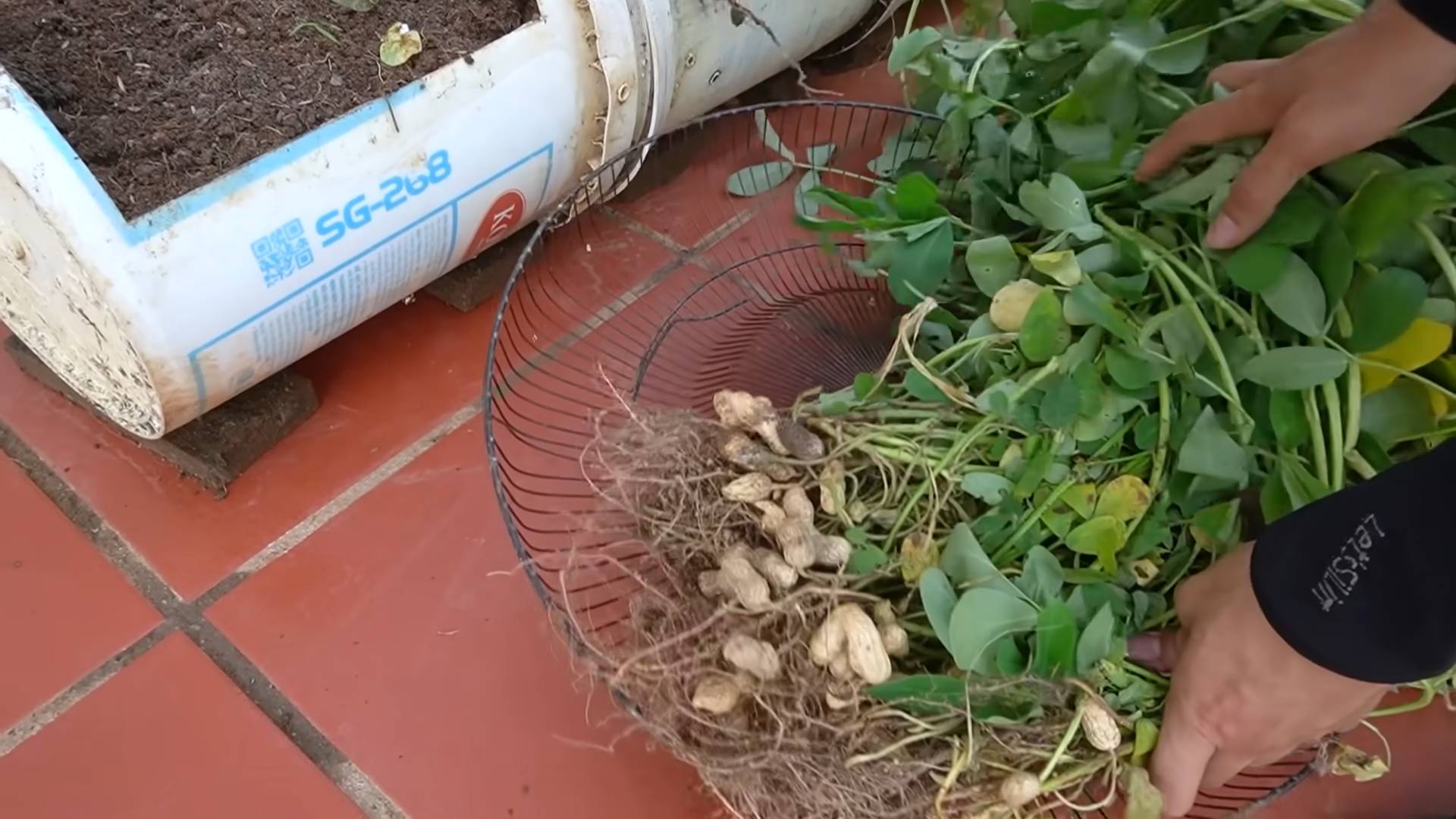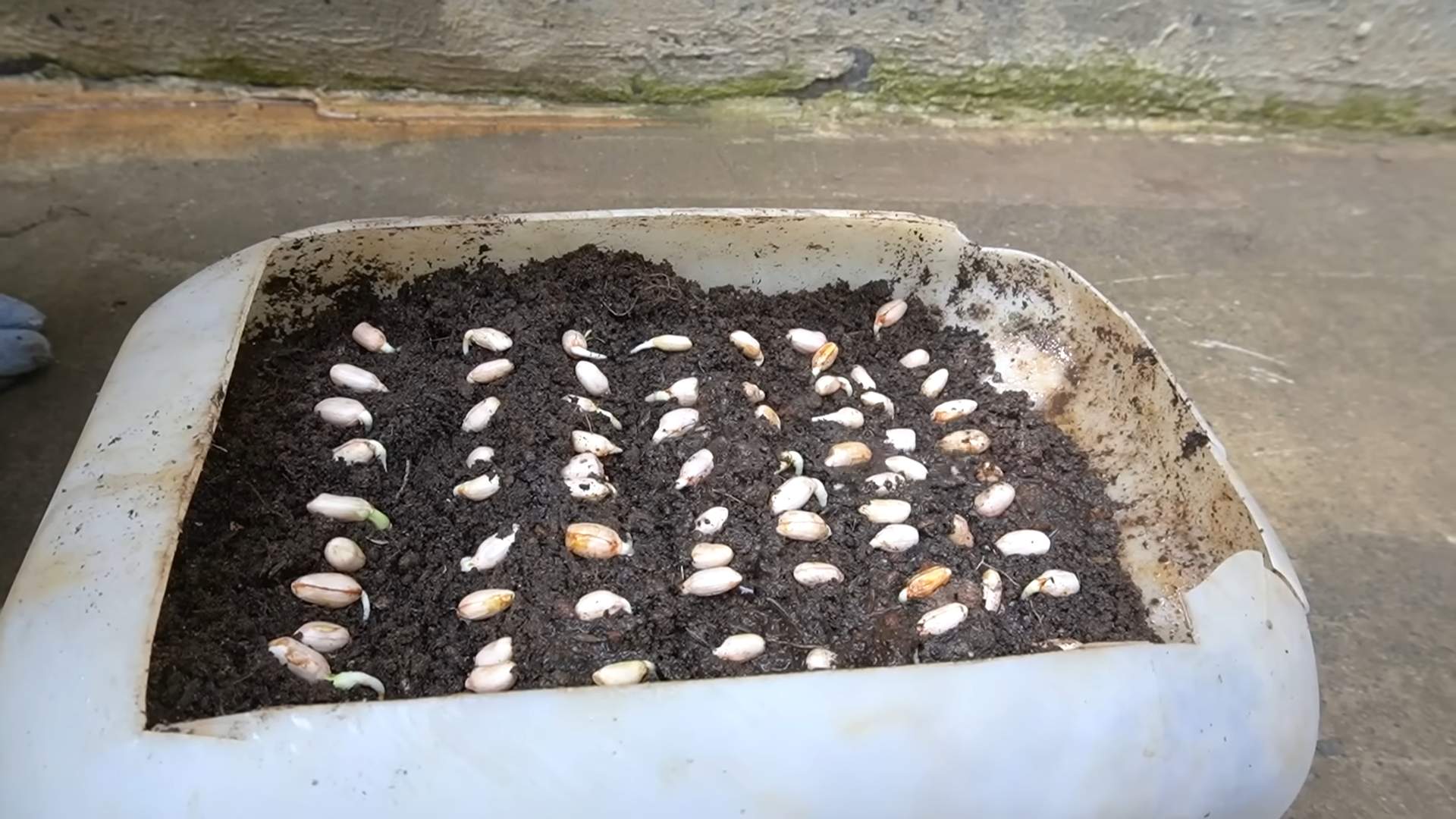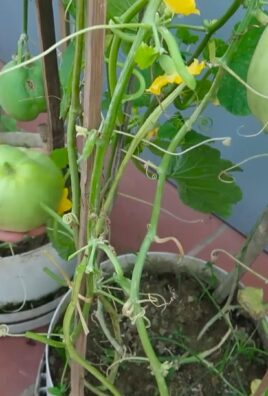Growing Cantaloupes in Barrels: Imagine biting into a juicy, sun-ripened cantaloupe, bursting with flavor, and knowing you grew it yourself, right in your backyard! Sounds idyllic, doesn’t it? But what if you don’t have a sprawling garden? That’s where this ingenious DIY trick comes in. For centuries, resourceful gardeners have sought innovative ways to cultivate delicious produce, even in limited spaces. From ancient rooftop gardens in bustling cities to modern-day container gardening, the desire to connect with nature and enjoy fresh, homegrown food has always been strong.
I’m here to tell you that you don’t need acres of land to enjoy the sweet taste of success. Growing cantaloupes in barrels is a fantastic solution for apartment dwellers, balcony gardeners, or anyone with limited ground space. This method not only maximizes your yield but also adds a touch of rustic charm to your outdoor area. Plus, it’s a fun and rewarding project that’s easier than you might think!
In this article, I’ll walk you through every step of the process, from selecting the right barrel and preparing the soil to nurturing your cantaloupe vines and harvesting your delicious bounty. Get ready to transform your small space into a cantaloupe oasis!

Growing Cantaloupes in Barrels: A Sweet DIY Project
Okay, so you want to grow cantaloupes, but you’re short on space? Or maybe you just want to try something a little different? Well, you’ve come to the right place! I’m going to walk you through how to grow delicious, juicy cantaloupes in barrels. It’s easier than you think, and the results are so rewarding. Trust me, nothing beats a homegrown cantaloupe on a hot summer day.
Why Barrels?
Before we dive in, let’s talk about why barrels are a great option for growing cantaloupes.
* Space Saving: Barrels are perfect for patios, balconies, or small gardens. You can grow a surprising amount of cantaloupe in a relatively small footprint.
* Improved Drainage: Good drainage is crucial for cantaloupes. Barrels, with proper drainage holes, help prevent root rot.
* Soil Control: You have complete control over the soil composition in your barrel, ensuring your cantaloupes get the nutrients they need.
* Warmer Soil: Barrels tend to warm up faster than the ground, giving your cantaloupes a head start in the growing season.
* Aesthetic Appeal: Let’s be honest, a barrel overflowing with cantaloupe vines looks pretty darn cool!
What You’ll Need
Alright, let’s gather our supplies. Here’s what you’ll need to get started:
* A Large Barrel: A half-barrel (approximately 25-30 gallons) is ideal. You can find these at garden centers, nurseries, or even online. Make sure it’s clean and free of any harmful chemicals if it was previously used for something else.
* Drill and Drill Bits: For creating drainage holes.
* Gravel or Rocks: For drainage at the bottom of the barrel.
* High-Quality Potting Mix: This is super important! Don’t skimp on the potting mix. You want something that drains well and is rich in nutrients. I recommend a mix specifically formulated for vegetables.
* Compost: Compost is your cantaloupe’s best friend. It adds nutrients and improves soil structure.
* Cantaloupe Seeds or Seedlings: You can start from seed indoors or purchase seedlings from a nursery. Choose a variety that’s well-suited to your climate.
* Slow-Release Fertilizer: This will provide a steady supply of nutrients throughout the growing season.
* Trellis or Support System: Cantaloupe vines can get heavy, so you’ll need something to support them. A trellis, tomato cage, or even sturdy stakes will work.
* Watering Can or Hose: For watering your cantaloupes.
* Gardening Gloves: To keep your hands clean.
* Mulch (Optional): Mulch helps retain moisture and suppress weeds. Straw, wood chips, or shredded bark are all good options.
Preparing the Barrel
Okay, let’s get our hands dirty! The first step is preparing the barrel.
1. Drill Drainage Holes: If your barrel doesn’t already have them, drill several drainage holes in the bottom. I usually go for about 4-5 holes, each about half an inch in diameter. This is crucial to prevent waterlogging, which cantaloupes absolutely hate.
2. Add Drainage Layer: Pour a layer of gravel or rocks into the bottom of the barrel. This will further improve drainage and prevent the potting mix from clogging the drainage holes. Aim for a layer that’s about 2-3 inches thick.
3. Fill with Potting Mix and Compost: Now, it’s time to fill the barrel with potting mix. Mix in a generous amount of compost – about one-third compost to two-thirds potting mix is a good ratio. This will provide your cantaloupes with the nutrients they need to thrive. Leave a few inches of space at the top of the barrel.
4. Incorporate Slow-Release Fertilizer: Mix in the slow-release fertilizer according to the package directions. This will provide a steady supply of nutrients throughout the growing season.
Planting Your Cantaloupes
Now for the fun part – planting!
1. Starting from Seed: If you’re starting from seed, sow the seeds directly into the barrel about 1 inch deep. Plant 2-3 seeds per hill, and thin them out to the strongest seedling once they emerge. Keep the soil consistently moist until the seeds germinate, which usually takes about 7-10 days.
2. Planting Seedlings: If you’re using seedlings, gently remove them from their containers and plant them in the barrel. Space the seedlings about 12-18 inches apart. Make sure the top of the root ball is level with the surrounding soil.
3. Water Thoroughly: After planting, water the cantaloupes thoroughly. This will help settle the soil and encourage root growth.
4. Add Mulch (Optional): If you’re using mulch, spread a layer around the base of the plants. This will help retain moisture, suppress weeds, and keep the soil cool.
Providing Support
Cantaloupe vines can get quite long and heavy, so providing support is essential.
1. Install Trellis or Support System: Install your trellis or support system as soon as you plant your cantaloupes. This will give the vines something to climb on as they grow.
2. Train the Vines: As the vines grow, gently train them to climb the trellis or support system. You can use plant ties or clips to secure the vines.
3. Support the Fruit: As the cantaloupes develop, you may need to provide additional support for the fruit. You can use slings made from pantyhose or netting to support the melons and prevent them from breaking off the vine.
Caring for Your Cantaloupes
Now that your cantaloupes are planted and supported, it’s time to provide them with the care they need to thrive.
1. Watering: Cantaloupes need consistent moisture, especially during hot weather. Water deeply and regularly, but avoid overwatering, which can lead to root rot. Check the soil moisture regularly and water when the top inch or two feels dry.
2. Fertilizing: Cantaloupes are heavy feeders, so they need regular fertilization. In addition to the slow-release fertilizer you added at planting, you can also supplement with a liquid fertilizer every 2-3 weeks. Choose a fertilizer that’s high in phosphorus and potassium, which are essential for fruit development.
3. Pruning: Pruning can help improve air circulation and encourage fruit production. Remove any dead or diseased leaves and stems. You can also pinch off the tips of the vines to encourage branching.
4. Pest and Disease Control: Keep an eye out for pests and diseases. Common cantaloupe pests include aphids, squash bugs, and cucumber beetles. Common diseases include powdery mildew and fusarium wilt. Treat any problems promptly with appropriate insecticides or fungicides. I always prefer organic options whenever possible.
5. Pollination: Cantaloupes need to be pollinated in order to produce fruit. If you’re not seeing any fruit development, you may need to hand-pollinate the flowers. To do this, use a small paintbrush to transfer pollen from the male flowers to the female flowers. The female flowers have a small fruit at the base of the flower.
Harvesting Your Cantaloupes
The moment you’ve been waiting for – harvesting!
1. Determining Ripeness: Knowing when to harvest cantaloupes can be tricky. Here are a few signs that your cantaloupe is ripe:
* The stem slips easily from the vine: This is the most reliable sign of ripeness. Gently tug on the stem where it connects to the fruit. If it slips easily, the cantaloupe is ready to harvest.
* The skin turns from green to tan or yellow: The color of the skin will change as the cantaloupe ripens.
* The cantaloupe has a sweet aroma: A ripe cantaloupe will have a sweet, musky aroma.
* The blossom end is slightly soft: Gently press on the blossom end of the cantaloupe. If it’s slightly soft, it’s likely ripe.
2. Harvesting: Once you’ve determined that your cantaloupe is ripe, gently twist it off the vine. Handle the cantaloupe carefully to avoid bruising it.
3. Enjoying Your Harvest: Now it’s time to enjoy the fruits (or rather, melons) of your labor! Cantaloupes are delicious eaten fresh, but they can also be used in smoothies, salads, and desserts.
Troubleshooting
Even with the best care, you may encounter some problems along the way. Here are a few

Conclusion
So, there you have it! Growing cantaloupes in barrels isn’t just a quirky gardening experiment; it’s a game-changer for anyone with limited space, challenging soil, or simply a desire for a more manageable and rewarding harvest. We’ve walked through the process, from selecting the right barrel and preparing the perfect soil mix to nurturing your cantaloupe vines and anticipating that sweet, juicy reward.
Why is this DIY trick a must-try? Because it democratizes cantaloupe cultivation! No longer are these delicious melons relegated to sprawling gardens. With a barrel, some sunshine, and a little dedication, you can enjoy homegrown cantaloupes even on a balcony or patio. The controlled environment of the barrel also allows for better water management and weed control, leading to healthier plants and potentially larger, more flavorful fruit. Plus, the elevated position of the barrel can help protect your precious melons from ground-dwelling pests and diseases.
But don’t think you’re limited to just one approach. Feel free to experiment! Consider adding companion plants like marigolds or basil around the base of your cantaloupe vines to deter pests naturally. You could also try different varieties of cantaloupe, from the classic Hale’s Best to more exotic options like the Charentais. For those in cooler climates, a dark-colored barrel can help absorb more heat, extending your growing season. And if you’re feeling particularly ambitious, you could even try training your cantaloupe vines up a trellis or support structure to maximize space and improve air circulation.
The key to success with growing cantaloupes in barrels is observation and adaptation. Pay close attention to your plants, adjust your watering and fertilizing schedule as needed, and don’t be afraid to experiment. The rewards – the unparalleled taste of a sun-ripened, homegrown cantaloupe – are well worth the effort.
We wholeheartedly encourage you to give this DIY trick a try. It’s a fun, rewarding, and surprisingly easy way to enjoy fresh, delicious cantaloupes, no matter where you live. And most importantly, we want to hear about your experience! Share your photos, tips, and triumphs in the comments below. Let’s build a community of barrel-growing cantaloupe enthusiasts and learn from each other’s successes (and occasional failures!). Happy gardening! Let us know how your journey of **growing cantaloupes in barrels** goes.
Frequently Asked Questions (FAQ)
1. What size barrel is best for growing cantaloupes?
A half-barrel (approximately 25-30 gallons) is generally considered the minimum size for growing a single cantaloupe plant. Larger barrels (40-55 gallons) are even better, as they provide more room for root growth and help retain moisture. Make sure the barrel has drainage holes to prevent waterlogging. You can use either plastic or wooden barrels, but ensure that wooden barrels are properly sealed or lined to prevent the wood from rotting.
2. What type of soil mix should I use?
Cantaloupes need well-draining, nutrient-rich soil. A good mix consists of equal parts:
* Potting soil: Provides a light and airy base.
* Compost: Adds essential nutrients and improves drainage.
* Peat moss or coco coir: Helps retain moisture.
You can also add a slow-release fertilizer to the mix to provide a steady supply of nutrients throughout the growing season. Avoid using garden soil, as it can be too heavy and may contain pests or diseases.
3. How often should I water my cantaloupe plants in a barrel?
Watering frequency depends on the weather and the drainage of your barrel. Generally, you should water deeply whenever the top inch of soil feels dry to the touch. Avoid overwatering, as this can lead to root rot. During hot, dry weather, you may need to water daily. Use a soaker hose or watering can to water at the base of the plant, avoiding wetting the foliage, which can encourage fungal diseases.
4. How much sunlight do cantaloupes need?
Cantaloupes need at least 6-8 hours of direct sunlight per day to thrive. Choose a location for your barrel that receives full sun. If you live in a particularly hot climate, some afternoon shade may be beneficial to prevent the plants from overheating.
5. When should I fertilize my cantaloupe plants?
Start fertilizing your cantaloupe plants about two weeks after transplanting them into the barrel. Use a balanced fertilizer (e.g., 10-10-10) diluted to half strength. Fertilize every 2-3 weeks throughout the growing season. Once the fruits start to develop, switch to a fertilizer higher in phosphorus and potassium to promote fruit production and sweetness.
6. How do I prevent pests and diseases?
Regularly inspect your plants for signs of pests or diseases. Common pests include aphids, squash bugs, and cucumber beetles. You can control these pests with insecticidal soap or neem oil. Common diseases include powdery mildew and fusarium wilt. To prevent these diseases, ensure good air circulation, avoid overwatering, and use disease-resistant varieties. You can also apply a fungicide if necessary.
7. How do I know when my cantaloupe is ripe?
There are several signs that indicate a cantaloupe is ripe:
* The stem starts to slip easily from the fruit.
* The skin turns from green to a tan or yellowish color.
* The melon develops a sweet aroma.
* The blossom end of the melon feels slightly soft.
Gently tap the melon; a ripe cantaloupe will sound hollow.
8. Can I grow more than one cantaloupe plant in a barrel?
While it’s possible to grow two cantaloupe plants in a very large barrel (50+ gallons), it’s generally best to stick to one plant per barrel. Overcrowding can lead to reduced fruit size and increased susceptibility to pests and diseases.
9. What are some good companion plants for cantaloupes?
Companion planting can help deter pests and improve the health of your cantaloupe plants. Good companion plants include:
* Marigolds: Repel nematodes and other pests.
* Basil: Repels aphids, whiteflies, and other insects.
* Nasturtiums: Attract aphids away from cantaloupe plants.
* Radishes: Deter cucumber beetles.
10. Can I move the barrel after planting?
It’s best to choose a permanent location for your barrel before planting, as moving it can stress the plants and disrupt their root systems. If you must move the barrel, do so carefully and gently, and try to avoid damaging the roots.
11. What if my cantaloupe vines are not producing fruit?
There are several reasons why your cantaloupe vines might not be producing fruit:
* Lack of pollination: Cantaloupes require pollination to set fruit. If there are not enough bees or other pollinators in your area, you may need to hand-pollinate the flowers.
* Insufficient sunlight: Cantaloupes need at least 6-8 hours of direct sunlight per day to produce fruit.
* Nutrient deficiencies: Cantaloupes need adequate nutrients to produce fruit. Make sure you are fertilizing regularly with a balanced fertilizer.
* Extreme temperatures: Extreme heat or cold can inhibit fruit production.
12. Can I grow cantaloupes in a barrel in a greenhouse?
Yes, growing cantaloupes in a barrel in a greenhouse is a great option, especially in cooler climates. The greenhouse will provide a warmer, more controlled environment, which can extend the growing season and improve fruit production. Make sure the greenhouse has adequate ventilation to prevent overheating and humidity buildup.
13. How do I hand-pollinate cantaloupe flowers?
Cantaloupes have separate male and female flowers. To hand-pollinate, use a small paintbrush or cotton swab to collect pollen from the male flower (which has a long, thin stem) and transfer it to the female flower (which has a small fruit at the base). Do this in the morning, when the flowers are open.
14. What are some common cantaloupe varieties that do well in barrels?
Some good cantaloupe varieties for growing in barrels include:
* Hale’s Best Jumbo
* Sugar Cube
* Minnesota Midget
* Charentais
Choose varieties that are known for their compact size and early maturity.
15. How do I store harvested cantaloupes?
Store ripe cantaloupes in the refrigerator for up to a week. Cut cantaloupe should be stored in an airtight container to prevent it from drying out.




Leave a Comment